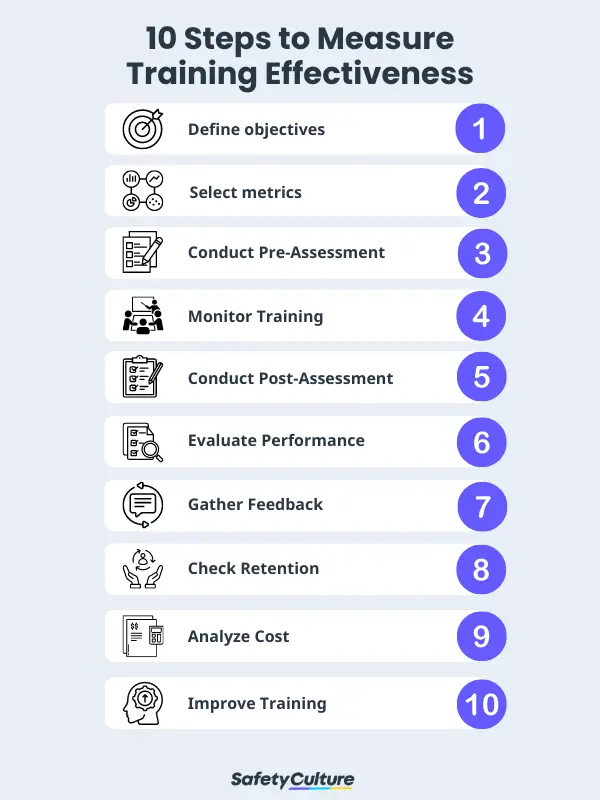What are Training Metrics?
Training metrics are measurements used to understand how well employees are learning and applying new skills or knowledge. These metrics help you evaluate the effectiveness of training programs by assessing factors such as:
- completion rates;
- performance improvement; and
- feedback from employees.
They also allow you to identify areas for improvement, track progress, and ensure that employees are equipped with the necessary skills for their roles.
Importance and Benefits
Training metrics offer a roadmap for training improvement and success. The importance and benefits of these metrics include:
- Evaluating Performance: Metrics like completion rates and assessment scores help measure how well employees grasp the training content.
- Identifying Gaps: By analyzing metrics, organizations can pinpoint areas where employees struggle or need additional support.
- Enhancing Programs: Regularly tracking metrics allows companies to refine their training initiatives for better outcomes.
- Increasing Engagement: Monitoring participation and feedback metrics helps ensure that employees are actively engaged in the learning process.
- Saving Money: Metrics also evaluate the return on investment by assessing the impact of training on employee performance and organizational goals.
Key Employee Training Metrics
Here are some key training metrics you can track to help you measure any training’s impact on the overall success of your organization:
- Completion Rates: Measures the percentage of employees who finish the training, indicating overall engagement.
- Retention Rates: Reflects how well employees retain what they’ve learned over time, ensuring lasting impact.
- Time to Competency: Evaluates how quickly employees become proficient in new skills, helping gauge training efficiency.
- Performance Improvement: Tracks changes in employees’ on-the-job performance post-training, indicating the effectiveness of the program.
- Feedback and Satisfaction: Employee feedback provides insights into the training experience, highlighting areas for improvement.
- Cost per Employee: Calculates the investment made per employee for training, helping assess cost-effectiveness.
These metrics give you a comprehensive view of the training process, from skill acquisition and engagement to its impact on job performance and overall satisfaction. Regularly monitoring these indicators allows you to refine your training strategies for continuous improvement.
How to Measure Training Effectiveness Metrics
The following steps can help you create a structured process to measure training effectiveness. All of these steps ensure that your efforts align with organizational goals and contribute to the ongoing development of employees:

- Define Objectives: Start by outlining specific, measurable goals for the training program. Think about what skills or knowledge employees should gain.
- Select Metrics: Choose metrics that align with your objectives. Consider completion rates, performance improvement, and employee feedback.
- Conduct Pre-Assessment: Before training begins, assess the employees’ current knowledge or skills in the targeted areas. This provides a baseline for comparison.
- Monitor Training: Keep an eye on participation and engagement during the training. Are employees actively involved? Use attendance records and participation data.
- Conduct Post-Assessment: After training, conduct assessments to measure the increase in knowledge or skills. Compare results to the pre-assessment to gauge improvement.
- Evaluate Performance: Monitor on-the-job performance post-training. Are employees applying what they learned? Look for improvements in key performance indicators (KPIs).
- Gather Feedback: Collect feedback from participants through surveys. Ask about the training’s relevance, effectiveness, and areas for improvement.
- Check Retention: Assess how well employees retain what they learned over time. Periodic follow-ups or quizzes can help determine long-term impact.
- Analyze Cost: Evaluate the cost-effectiveness of the training by comparing the investment to the results achieved. Consider factors like increased productivity or reduced errors.
- Improve Training: Use the gathered data to refine future training programs. Identify what worked well and what could be enhanced for better effectiveness.
Challenges
Training metrics might be difficult to gauge accurately due to various factors:
- Subjectivity: Employee feedback and self-assessment are subjective, so it’s challenging to get an objective measure of training impact.
- Lack of Resources: Limited resources, such as time and budget constraints can hinder the data-gathering process before analysis.
- External Factors: External influences, like changes in job roles or market conditions, affect on-the-job performance, making it difficult to attribute improvements solely to training.
- Difficulty in Quantifying Soft Skills: Soft skills, such as communication or teamwork, are vital but tricky to quantify. This poses a challenge in assessing their development through training.
- Overemphasis on Immediate Results: Some training outcomes take time to manifest, and the pressure for immediate results leads to an incomplete picture of the training’s effectiveness.
- Inconsistent Metrics Across Programs: Different training programs use varied metrics, so it can be challenging to compare effectiveness consistently across the organization.
Despite these challenges, a thoughtful approach, clear objectives, and a commitment to continuous improvement can help organizations navigate and address these hurdles in measuring training metrics effectively.
Best Practices
Despite these challenges, there are best practices that can help you navigate and address such hurdles in effectively measuring training metrics that matter:
- Mix of Quantitative and Qualitative Data: Use a combination of numbers (quantitative data) and employee feedback (qualitative data) for a more comprehensive evaluation.
- Realistic Timeframes: Understand that some training outcomes may take time to show. Set realistic timeframes for assessing the impact.
- Consistent Metrics Across Programs: Maintain consistency in the metrics used across different training programs for easier comparison and analysis.
- Digital and Automated Process: A digital training solution streamlines training metrics analysis and evaluation by offering real-time assessments and analytics for optimizing training effectiveness.
By incorporating these best practices with the steps outlined in this article, you can have thorough and meaningful training evaluation metrics for your employees.



